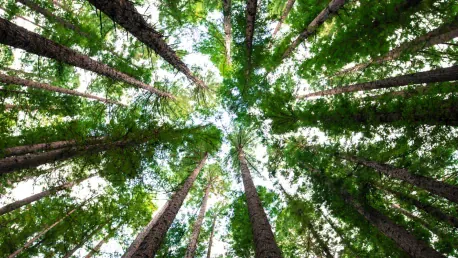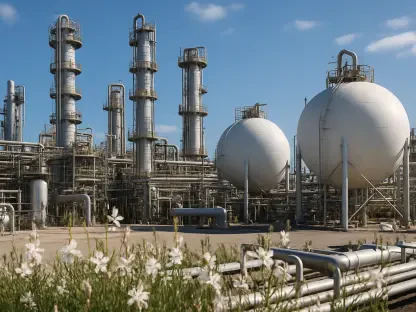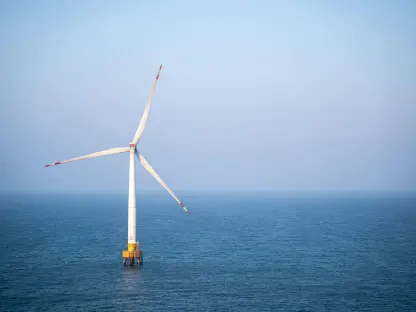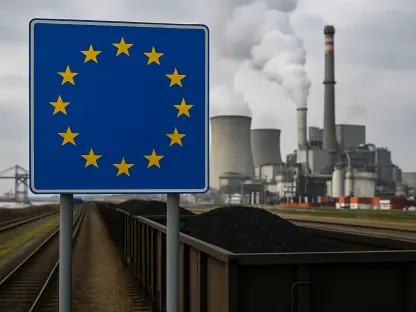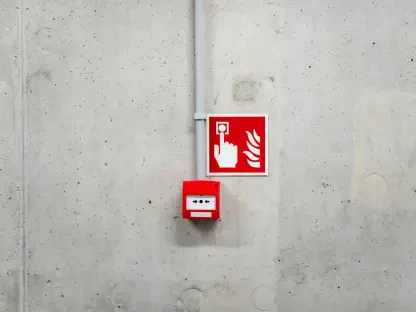Urban heat islands (UHIs) are a growing concern in many cities, including Birmingham, Alabama. These areas experience significantly higher temperatures than their rural surroundings due to human activities and infrastructure. The “Cool Green Trees” initiative aims to address this issue by planting trees in underserved neighborhoods, providing both environmental and socioeconomic benefits.
Urban heat islands occur when dense concentrations of pavement, buildings, and other surfaces that absorb and retain heat replace natural land cover. This phenomenon leads to higher temperatures, especially during the summer months, exacerbating the effects of heatwaves and increasing energy consumption for cooling. The elevated temperatures in UHIs can have severe health implications, particularly for vulnerable populations such as the elderly, children, and those with pre-existing health conditions. Increased heat can lead to heat-related illnesses, respiratory problems, and even higher mortality rates during extreme heat events.
Understanding Urban Heat Islands
Urban heat islands (UHIs) are a pressing issue in many urban areas, characterized by significantly higher temperatures compared to their rural surroundings. This temperature difference is primarily caused by human activities and the prevalence of infrastructure such as buildings, roads, and other surfaces that absorb and retain heat. The impact of UHIs is especially pronounced during the summer months, where cities like Birmingham can experience extreme heat conditions that exacerbate heatwaves and increase energy consumption for cooling.
The Science Behind Urban Heat Islands
The concept of urban heat islands emerges from the way modern cities are built. Natural landscapes, which typically consist of vegetation and water bodies, are replaced by materials like concrete, asphalt, and steel. These materials have a higher thermal mass, meaning they absorb and store heat throughout the day and release it more slowly at night. This results in higher ambient temperatures, especially in densely built areas, compared to less developed or rural areas.
The phenomenon is further intensified by the “heat island effect,” which is aggravated by man-made activities such as the operation of vehicles, industrial processes, and the widespread use of air conditioning units. These activities not only generate heat but also emit pollutants that can trap heat in the lower atmosphere, creating a feedback loop that exacerbates the problem. Consequently, urban residents experience more intense and prolonged heatwaves, and the urban infrastructure is subjected to greater thermal stress, leading to faster deterioration and higher maintenance costs.
Impact on Public Health
Urban heat islands pose significant public health challenges, particularly for vulnerable groups such as the elderly, children, and individuals with pre-existing health conditions. During periods of extreme heat, the risks of heat-related illnesses, such as heat exhaustion and heat stroke, increase substantially. Vulnerable populations, who may lack access to adequate cooling or air-conditioned environments, are at heightened risk of experiencing severe health outcomes.
Furthermore, the elevated temperatures associated with UHIs can exacerbate respiratory conditions by increasing the concentration of ground-level ozone and other air pollutants. High temperatures contribute to the formation of smog, which can aggravate asthma and other respiratory disorders. Studies have shown a correlation between higher urban temperatures and increased hospital admissions for respiratory and cardiovascular conditions.
The health impacts of UHIs extend beyond immediate heat-related illnesses. Chronic exposure to high temperatures can lead to long-term health problems, including kidney and cardiovascular diseases. During extreme heat events, the mortality rate can rise significantly, particularly in regions where residents are not accustomed to high temperatures or lack adequate infrastructure to mitigate the heat. Addressing UHIs is thus not only an environmental necessity but also a critical public health imperative.
The Cool Green Trees Initiative
The Cool Green Trees initiative was launched as a targeted response to the growing concerns associated with urban heat islands in Birmingham. The project, spearheaded by environmental scientist Francesca Gross, aims to combat the effects of UHIs by increasing the city’s tree canopy, particularly in areas that have been historically marginalized. By planting trees, the initiative seeks to provide both environmental and social benefits, helping to create cooler, healthier, and more equitable urban spaces.
Origins and Objectives
The Cool Green Trees initiative was founded in September 2022 by Francesca Gross, who identified the pressing need to address the urban heat island effect in Birmingham. The project was born out of a recognition that certain neighborhoods, particularly those affected by historical practices like redlining, suffer disproportionately from the impacts of higher urban temperatures. These areas often lack sufficient green spaces and tree cover, leading to elevated temperatures and poorer air quality compared to other parts of the city.
The primary objective of Cool Green Trees is to increase the tree canopy in Birmingham’s underserved neighborhoods. By planting trees, the initiative aims to cool urban areas, thereby reducing the temperature differential between urban and rural areas that characterizes urban heat islands (UHIs). Additionally, the initiative seeks to address environmental inequities by focusing on neighborhoods that have historically been neglected. Trees provide numerous ecological benefits, such as improved air quality, reduction of stormwater runoff, and increased biodiversity, all of which contribute to creating a healthier urban environment.
Strategic Planning and Mapping
Strategic planning and the use of data are central to the success of the Cool Green Trees initiative. To identify the most critical areas for intervention, the project utilizes detailed environmental data from the EPA’s EnviroAtlas. This comprehensive dataset enables the identification of “green opportunity areas” based on factors such as air pollution levels, flooding risks, and existing tree canopy coverage. Collaborating with UAB’s GIS specialist, the initiative developed a Green Opportunities Map, which visually represents these areas and guides the tree-planting efforts.
The mapping process revealed significant overlaps between green opportunity areas and historical redlining maps. Redlining was a discriminatory practice that involved denying services, often financial and housing-related, to residents of certain areas based on race or ethnicity. This practice resulted in long-lasting environmental and socioeconomic disparities. By overlaying environmental data with historical redlining maps, the Cool Green Trees initiative pinpointed neighborhoods that are in dire need of greening interventions. This targeted approach ensures that the benefits of increased tree canopy are directed towards communities that have historically been marginalized and underserved.
Community Engagement and Volunteering
Volunteering provides an opportunity to contribute positively to the community while also gaining valuable skills and experience. By engaging in community service, individuals can make a significant impact on the lives of others, fostering a sense of unity and purpose. It is also an excellent way to meet new people, build networks, and learn more about local needs and resources. Participating in volunteer activities not only benefits those being helped but also enriches the lives of the volunteers themselves, creating a shared sense of fulfillment and accomplishment.
Community involvement is a cornerstone of the Cool Green Trees initiative. Ensuring the success of the project requires active participation from local residents, volunteers, and other stakeholders. By engaging the community, the initiative fosters a sense of ownership and stewardship over the newly planted trees, which is essential for their long-term maintenance and sustainability.
Mobilizing Volunteers
Mobilizing volunteers is one of the key strategies employed by the Cool Green Trees initiative. Volunteers from various backgrounds, including local residents, students, and environmental enthusiasts, participate in tree-planting events. These activities not only help to increase the city’s tree canopy but also create opportunities for community members to come together and collaborate towards a common goal. The act of planting trees fosters a sense of environmental stewardship, encouraging volunteers to take an active role in caring for their local environment.
The initiative’s volunteer-driven approach also helps to build stronger community bonds. By involving residents in the tree-planting process, the project creates a shared experience that can strengthen social ties and promote a sense of community pride. Volunteers gain a sense of accomplishment and connection to their neighborhood, which can translate into increased support for other local environmental and social initiatives.
Success Stories
The success of the Cool Green Trees initiative is reflected in the numerous tree-planting events that have taken place across Birmingham. One notable event saw thirty trees planted along 16th Avenue West and Center Street North in the East Thomas neighborhood. Volunteers such as Erin Hackenmueller, Adrian Smith, and Grace Dugger played a crucial role in these efforts, demonstrating the power of collective action in addressing environmental challenges.
These tree-planting events have not only increased the tree canopy but also brought attention to the importance of urban greening. Local media coverage and community feedback have highlighted the positive impact of the initiative, encouraging more residents to get involved. The success stories serve as a testament to the effectiveness of community engagement in achieving environmental goals and showcase the potential for similar initiatives to be replicated in other cities facing similar challenges.
Environmental and Health Benefits
The environmental and health benefits of urban tree planting are well-documented. Trees play a vital role in cooling urban areas, improving air quality, and managing stormwater runoff, all of which contribute to creating healthier and more sustainable cities. The Cool Green Trees initiative aims to harness these benefits to address the specific challenges posed by urban heat islands in Birmingham.
Cooling Urban Areas
One of the primary benefits of increasing the tree canopy in urban areas is the natural cooling effect provided by trees. Through the process of evapotranspiration, trees release water vapor into the air, which helps to lower ambient temperatures. Additionally, trees provide shade, which reduces the amount of heat absorbed by urban surfaces such as roads and buildings. This cooling effect can significantly lower temperatures in urban heat islands, making cities more livable during hot weather.
The shade provided by trees not only cools the surrounding environment but also reduces the need for air conditioning. This can lead to lower energy consumption and reduced greenhouse gas emissions, contributing to climate change mitigation. The cooling effect of trees is particularly important in densely built urban areas where heat tends to be trapped, creating pockets of extreme heat. By strategically planting trees in these areas, the Cool Green Trees initiative aims to create cooler microclimates that enhance the overall comfort and well-being of residents.
Improving Air Quality and Reducing Flooding
In addition to their cooling effects, trees play a crucial role in improving air quality in urban areas. They absorb pollutants such as nitrogen dioxide, sulfur dioxide, and particulate matter, which can have harmful effects on human health. Trees also produce oxygen, contributing to cleaner and fresher air. Improved air quality can lead to better respiratory health outcomes, particularly for vulnerable populations such as children and the elderly.
Trees are also effective at managing stormwater runoff, a critical issue in urban areas with large expanses of impermeable surfaces. During heavy rainfall, these surfaces can quickly become overwhelmed, leading to flooding and water pollution. Trees help to mitigate these issues by absorbing excess rainfall and reducing the volume of runoff. Their root systems also help to stabilize soil and prevent erosion, further contributing to flood management. The Cool Green Trees initiative recognizes the multifaceted benefits of trees, making them a central component of urban sustainability efforts.
Collaborative Efforts and Partnerships
The success of the Cool Green Trees initiative is heavily reliant on the collaborative efforts of various stakeholders. Partnerships with local institutions, government agencies, and community organizations provide essential resources, expertise, and support, ensuring the effectiveness and sustainability of the project.
Institutional Support
In its deliberate approach to addressing the complexities of cryptocurrencies, the SEC opted for another delay in its verdict on the spot Ethereum ETF. The extension grants the SEC an opportunity not only to conduct an in-depth examination of Ethereum’s suitability for ETF status but also to source public insight, which could heavily sway the conclusion. This speaks to the SEC’s attentiveness to the nuances of digital assets and their integration into regulatory frameworks, which it does not take lightly. The situation closely parallels the stalling faced by Grayscale, who is also waiting for the green light to transform its Ethereum Trust into a spot ETF, raising questions about the contrasting regulatory processes for Bitcoin and Ethereum.
One of the key factors contributing to the success of the Cool Green Trees initiative is the support from local institutions. Partnerships with entities such as the University of Alabama at Birmingham (UAB), the City of Birmingham, and the Jefferson County Health Department have provided critical resources and expertise to the project. These collaborations enable the initiative to leverage academic knowledge, municipal infrastructure, and public health insights to maximize its impact.
For example, UAB’s involvement has been instrumental in the strategic planning and data analysis phases of the project. Utilizing UAB’s GIS specialist and the EPA’s EnviroAtlas, the initiative developed the Green Opportunities Map, which guides tree-planting efforts by identifying areas in dire need of greening. The City of Birmingham provides logistical support and coordination, facilitating tree-planting activities and ensuring that they align with urban development plans. The Jefferson County Health Department’s endorsement underscores the public health benefits of the initiative, helping to garner broader community and institutional support.
Role of the Birmingham Department of Transportation
The Birmingham Department of Transportation is responsible for maintaining and improving the city’s infrastructure, including roads, bridges, and public transit systems. By ensuring the safe and efficient movement of people and goods, the department supports the local economy and enhances the quality of life for residents. Additionally, the department is involved in planning and implementing projects that promote sustainable and environmentally friendly transportation options for the city’s future.
The Birmingham Department of Transportation (BDOT) is another key partner in the Cool Green Trees initiative. BDOT’s role highlights the multifaceted benefits of tree planting, extending beyond environmental and health impacts to include improvements in urban infrastructure and quality of life. According to BDOT Director James Fowler, trees enhance walkability by providing natural shading and creating more pleasant pedestrian environments. Shaded sidewalks and streets encourage more pedestrian activity, which can lead to increased physical activity and reduced reliance on automobiles.
Moreover, trees contribute to a more aesthetically pleasing urban landscape. The presence of greenery can enhance the visual appeal of neighborhoods, making them more attractive to residents and visitors alike. This can have positive economic implications, as well-maintained and aesthetically pleasing areas are often associated with higher property values and increased commercial activity. By recognizing and promoting these diverse benefits, the Cool Green Trees initiative and its partners demonstrate a comprehensive approach to urban sustainability.
Measurable Impact and Future Goals
The Cool Green Trees initiative has achieved significant milestones since its inception, demonstrating its effectiveness and commitment to creating a more sustainable and equitable urban environment. The project’s measurable impact is reflected in the number of trees planted and the long-term goals set to ensure continued progress.
Achievements to Date
Since its launch, the Cool Green Trees initiative has made impressive strides in increasing Birmingham’s tree canopy. In 2023 alone, the project successfully planted 612 trees, with plans to plant 660 more in 2024 and an additional 600 in 2025. These numbers not only meet but exceed the grant requirements, showcasing the initiative’s efficiency and commitment to its objectives. The substantial increase in tree planting has helped to mitigate the urban heat island effect, improve air quality, and enhance the overall environmental health of the city.
The project’s success is also evident in the positive feedback from the community and local media coverage. The initiative has raised awareness about the importance of urban greening and inspired other cities to consider similar efforts. By documenting its achievements and sharing best practices, the Cool Green Trees initiative serves as a model for urban greening projects in other regions facing similar environmental and health challenges.
Long-Term Sustainability
Ensuring the long-term sustainability of the newly planted trees is a critical aspect of the Cool Green Trees initiative. The project’s comprehensive approach includes regular monitoring and maintenance to ensure the trees’ health and longevity. This involves watering, mulching, pruning, and protecting the trees from pests and diseases. By committing to ongoing care, the initiative aims to maximize the environmental and health benefits provided by the trees.
The focus on long-term sustainability extends to community engagement and education. The initiative organizes workshops and training sessions to educate residents about tree care and the benefits of urban greening. By empowering the community with the knowledge and skills to care for the trees, the project fosters a sense of ownership and responsibility. This community-driven approach increases the likelihood that the trees will be well-maintained and thrive, ensuring lasting positive impacts on the urban environment.
Addressing Historical Injustices
Throughout history, various groups and communities have faced systemic inequalities and injustices that have hindered their progress and well-being. Efforts to address these historical injustices involve recognizing past wrongs, implementing policies that promote equity, and fostering an environment where opportunities are accessible to everyone. By taking deliberate actions to rectify these injustices, society can move toward a more inclusive and fair future for all individuals, regardless of their background or circumstances.
The Cool Green Trees initiative not only addresses environmental and health issues but also seeks to rectify some of the historical injustices that have contributed to these problems. By prioritizing tree planting in neighborhoods affected by redlining and other discriminatory practices, the project aims to promote environmental justice and social equity.
The Legacy of Redlining
Redlining was a discriminatory practice in which banks and other institutions denied services, such as loans and insurance, to residents of certain areas based on race or ethnicity. This practice, which persisted for several decades in the 20th century, had lasting negative impacts on the affected communities. Areas that were redlined often experienced disinvestment, leading to a lack of essential services and infrastructure, including green spaces and tree cover.
The legacy of redlining is still evident in many urban areas today. Neighborhoods that were subjected to redlining often have higher temperatures, poorer air quality, and increased flooding risks compared to other parts of the city. The Cool Green Trees initiative aims to address these disparities by focusing tree planting efforts in these historically marginalized areas. By increasing the tree canopy, the project seeks to improve environmental conditions and enhance the quality of life for residents.
Promoting Environmental Justice
Improving and maintaining environmental justice requires a thorough understanding of the disparities affecting marginalized communities, including issues like pollution exposure and access to clean air and water. Comprehensive strategies should be implemented to address these inequities, ensuring that all communities benefit from environmental protections. Collaboration between government, businesses, and local communities is essential to driving meaningful change and fostering a more equitable and sustainable future for everyone.
Promoting environmental justice is a core principle of the Cool Green Trees initiative. The project recognizes that environmental benefits should be equitably distributed and that historically marginalized communities should not bear a disproportionate burden of environmental harms. By prioritizing underserved neighborhoods, the initiative ensures that the benefits of urban greening are shared more equitably across all segments of the population.
The project’s focus on environmental and social equity extends beyond tree planting. It involves engaging residents in the planning and implementation process, ensuring that their voices are heard and their needs are addressed. This participatory approach not only enhances the project’s effectiveness but also empowers the community and builds trust. By fostering a sense of ownership and collective action, the Cool Green Trees initiative contributes to building more resilient and just urban communities.
The Role of Data in …
The use of data is crucial in guiding and optimizing the efforts of the Cool Green Trees initiative. By leveraging detailed environmental data and advanced mapping techniques, the project can strategically target areas that would benefit most from tree planting. This data-driven approach ensures that resources are used efficiently and that the initiative’s goals of environmental sustainability and social equity are met.
In conclusion, the Cool Green Trees initiative demonstrates how targeted tree planting can effectively combat urban heat islands, promote environmental justice, and improve public health. Through community engagement, strategic planning, and collaborative efforts, the project has made significant strides in creating a more sustainable and equitable urban environment in Birmingham. The initiative’s success serves as a model for other cities and underscores the importance of addressing environmental and social disparities to build healthier, more resilient communities.
